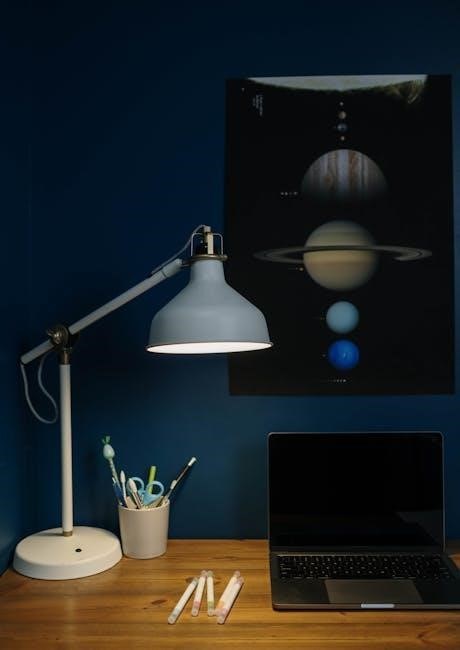Solar lighting systems convert sunlight into electricity using photovoltaic modules‚ providing reliable illumination while reducing energy costs and carbon emissions. These systems are essential for sustainable development.
1.1 Overview of Solar Lighting Technology
Solar lighting technology harnesses sunlight through photovoltaic modules‚ converting it into electrical energy stored in batteries. This energy powers LED fixtures‚ offering eco-friendly‚ cost-effective illumination; The system includes solar panels‚ charge controllers‚ and energy storage‚ providing reliable light while minimizing environmental impact and reducing reliance on non-renewable energy sources.
1.2 Importance of Solar Lighting in Modern Applications
Solar lighting plays a pivotal role in modern sustainability efforts‚ offering energy efficiency and reliability. It reduces carbon emissions and operating costs‚ making it ideal for residential‚ commercial‚ and public spaces. Solar systems ensure consistent illumination during power outages and are cost-effective for remote areas with limited grid access‚ promoting widespread adoption.
Components of a Solar Lighting System
A solar lighting system includes solar panels‚ battery storage‚ charge controllers‚ LED fixtures‚ and mounting hardware‚ working together to convert sunlight into reliable‚ energy-efficient illumination solutions.
2.1 Solar Panels (Photovoltaic Modules)
Solar panels‚ or photovoltaic modules‚ are the heart of solar lighting systems. Comprising silicon cells‚ they convert sunlight into electricity. Available in monocrystalline or polycrystalline types‚ they vary in efficiency and size. Proper installation ensures maximum energy absorption‚ making them a key component for reliable power generation in solar lighting setups.
2.2 Battery Storage Systems
Battery storage systems are crucial for storing excess energy generated by solar panels during the day. They ensure continuous power supply at night or during cloudy conditions. Typically‚ deep-cycle lead-acid or lithium-ion batteries are used‚ offering reliable performance. Proper sizing and maintenance of batteries are essential for optimal energy storage and system longevity.
2.3 Charge Controllers
Charge controllers regulate the flow of energy between solar panels‚ batteries‚ and lighting fixtures. They prevent overcharging‚ protect against voltage spikes‚ and optimize energy harvesting. MPPT (Maximum Power Point Tracking) controllers are preferred for their efficiency‚ ensuring maximum energy transfer from the solar panel to the battery‚ enhancing overall system performance and reliability.
2.4 LED Lighting Fixtures
LED lighting fixtures are energy-efficient and durable‚ making them ideal for solar systems. They provide bright‚ white light with minimal power consumption. LEDs are often equipped with dimming controls and motion sensors‚ enhancing functionality. Their long lifespan and low maintenance make them a reliable choice for both residential and commercial solar lighting applications.
2.5 Mounting and Wiring Systems
Mounting and wiring systems ensure secure installation and efficient energy transfer. Adjustable mounting structures allow optimal solar panel alignment. Wiring connects components like panels‚ batteries‚ and LEDs. Proper insulation and waterproofing protect against weather conditions‚ ensuring longevity and safety. These systems are crucial for reliable operation in various environmental conditions.
Types of Solar Lighting Systems
Solar lighting systems are categorized into residential‚ commercial‚ and street/public applications. Each type is designed for specific energy needs‚ ensuring efficient illumination and energy conservation.
3.1 Residential Solar Lighting Systems
Residential solar lighting systems provide energy-efficient illumination for homes‚ reducing electricity costs. They include solar panels‚ batteries‚ and LED fixtures‚ offering reliable power during outages. These systems are ideal for indoor and outdoor use‚ promoting sustainability and lowering carbon footprints while enhancing home safety and aesthetics.
3.2 Commercial Solar Lighting Systems
Commercial solar lighting systems are designed for businesses‚ offering scalable solutions to reduce energy costs. They provide reliable illumination for parking lots‚ pathways‚ and buildings‚ enhancing safety and visibility. These systems are energy-efficient‚ environmentally friendly‚ and customizable to meet specific commercial needs‚ ensuring long-term savings and sustainability for businesses of all sizes.
3.3 Street and Public Solar Lighting Systems
Street and public solar lighting systems provide energy-efficient illumination for urban areas‚ enhancing safety and visibility. These systems include solar panels‚ batteries‚ and LED fixtures‚ designed for durability and low maintenance. They are ideal for streets‚ parks‚ and public spaces‚ reducing energy costs and environmental impact while improving community safety and accessibility.
Benefits of Solar Lighting Systems
Solar lighting systems reduce energy costs‚ minimize carbon footprint‚ and require low maintenance. They offer reliable illumination while promoting sustainability and energy independence‚ benefiting both environments and budgets.
4.1 Energy Efficiency and Cost Savings
Solar lighting systems offer significant energy efficiency and cost savings by harnessing renewable energy‚ reducing electricity bills‚ and minimizing operating costs. LED fixtures and optimized system sizing ensure long-term savings. While initial investments are higher‚ incentives and lower maintenance contribute to substantial financial benefits over time.
4.2 Environmental Impact Reduction
Solar lighting systems significantly reduce environmental impact by utilizing renewable energy‚ lowering carbon emissions‚ and minimizing reliance on fossil fuels. They contribute to global sustainability goals by reducing greenhouse gases and promoting eco-friendly practices‚ making them a vital solution for combating climate change and preserving natural resources for future generations.
Solar lighting systems are highly reliable‚ providing consistent performance with minimal maintenance. They feature durable components like LED fixtures and advanced battery storage‚ ensuring long lifespans. Automated charge controllers prevent overcharging‚ reducing wear and tear. This makes them ideal for remote or hard-to-reach locations‚ offering hassle-free illumination with minimal upkeep requirements over time.

Designing a Solar Lighting System
4.3 Reliability and Low Maintenance
Solar lighting systems are highly reliable‚ requiring minimal maintenance due to their durable components like LED fixtures and battery storage. Automated charge controllers ensure efficient energy management‚ reducing wear and tear. This makes them ideal for remote locations‚ providing consistent illumination with minimal upkeep‚ ensuring long-term performance and reliability.
5.1 Assessing Lighting Requirements
Assessing lighting requirements involves evaluating illumination needs‚ location‚ and usage patterns. Determine the type of fixtures‚ wattage‚ and coverage area. Consider energy efficiency and local regulations. Use tools like lumens per watt calculations to ensure optimal performance and energy savings‚ aligning with the system’s capacity and user expectations for reliable operation.
5.2 Selecting Appropriate Components
Selecting components involves choosing solar panels‚ batteries‚ charge controllers‚ and LED fixtures that match the system’s energy needs. Consider efficiency‚ durability‚ and compatibility. Ensure solar panels have sufficient wattage‚ batteries provide adequate storage‚ and fixtures meet lighting requirements. Proper component selection ensures reliability‚ efficiency‚ and long-term performance of the solar lighting system.
5.3 Sizing the System for Optimal Performance
Sizing involves assessing energy requirements and selecting components to ensure optimal performance. Evaluate PV module ratings‚ battery capacity‚ and charge controller specifications based on load demands and location. Proper sizing ensures the system meets lighting needs efficiently‚ avoids energy shortages‚ and maintains reliability under varying conditions and usage patterns.

Installation and Setup
Installation involves site selection‚ mounting solar panels and components‚ and connecting wiring. Proper setup ensures efficient energy capture‚ storage‚ and distribution for reliable lighting operation.
6.1 Site Selection and Preparation
Site selection involves assessing sunlight exposure‚ shading‚ and accessibility. Ensure the area receives adequate solar radiation and is free from obstructions. Prepare the ground by leveling and clearing debris. Proper preparation ensures optimal system performance‚ longevity‚ and safety‚ while adhering to local regulations and environmental considerations.
6.2 Mounting and Connecting Components
Mount solar panels at optimal angles and directions for maximum sunlight exposure. Securely install LED fixtures and connect wiring to batteries and charge controllers. Ensure all connections are weatherproof and comply with safety standards. Proper mounting and wiring ensure efficient energy flow and system reliability‚ minimizing risks of electrical faults and performance issues.
6.3 Testing and Commissioning
Test the system to ensure all components function correctly. Verify battery capacity‚ LED performance‚ and charge controller efficiency. Conduct load testing to confirm the system meets illumination requirements. Inspect all connections for integrity and safety. Commissioning involves final checks to ensure seamless operation under various conditions‚ guaranteeing reliability and optimal performance of the solar lighting system.

Maintenance and Troubleshooting
Regular cleaning of solar panels and battery checks ensure optimal performance. Troubleshooting involves identifying issues like faulty charge controllers or LED failures for timely resolution.
7.1 Regular Maintenance Practices
Regular maintenance ensures optimal performance of solar lighting systems. This includes cleaning solar panels to remove dirt and debris‚ inspecting battery storage for charge levels‚ and checking wiring connections. Additionally‚ monitoring LED brightness and ensuring charge controllers function properly are essential practices to maintain efficiency and extend system lifespan.
7.2 Common Issues and Solutions
Common issues include reduced battery life‚ dimming lights‚ or system shutdowns. Solutions involve ensuring proper solar panel shading‚ cleaning panels regularly‚ and checking charge controller settings. Replacing old batteries and verifying wiring connections can resolve most problems‚ ensuring reliable performance and extending system longevity.

Future Trends in Solar Lighting
Future trends include integration with smart grids and IoT for real-time monitoring‚ advancements in LED technology‚ and improved energy storage solutions‚ enhancing efficiency and sustainability.
8.1 Advancements in LED Technology
Advancements in LED technology are revolutionizing solar lighting systems‚ offering higher efficiency‚ longer lifespan‚ and improved luminescence. High-power white LEDs with superior thermal management are enhancing performance‚ while new designs enable better light distribution and energy savings‚ making solar lighting more sustainable and cost-effective.
8.2 Integration with Smart Grids and IoT
The integration of solar lighting systems with smart grids and IoT enhances energy management and efficiency. Real-time monitoring‚ remote control‚ and adaptive lighting adjustments optimize performance. IoT-enabled systems ensure seamless communication between components‚ improving reliability and reducing operational costs while promoting sustainable energy solutions.
8.3 Energy Storage Innovations
Advancements in energy storage‚ such as lithium-ion and LiFePo4 batteries‚ improve solar lighting system efficiency. These innovations enable longer backup periods and faster charging‚ ensuring reliable operation during low sunlight conditions. Enhanced battery management systems optimize energy utilization‚ making solar lighting systems more sustainable and cost-effective for various applications.
Case Studies and Applications
Solar lighting systems are widely applied in residential‚ commercial‚ and public settings‚ including street lights and home systems‚ ensuring reliable and sustainable illumination in various environments.
9.1 Residential Applications
Solar lighting systems are increasingly used in homes for energy-efficient illumination‚ reducing electricity costs. They provide reliable lighting during power outages and are ideal for outdoor spaces‚ enhancing safety and aesthetics while promoting sustainability.
9.2 Commercial and Industrial Applications
Solar lighting systems are widely adopted in commercial and industrial settings to reduce energy costs and enhance safety. They are ideal for parking lots‚ warehouses‚ and large facilities‚ offering scalable solutions to meet high lighting demands while ensuring reliability and minimizing maintenance.
9.3 Public and Urban Applications
Solar lighting systems are increasingly used in public spaces‚ such as streets‚ parks‚ and plazas‚ to provide eco-friendly illumination. They enhance urban safety‚ reduce energy consumption‚ and offer reliable performance‚ making them a sustainable solution for municipal lighting needs while lowering operational costs for cities and communities.

Cost Analysis and ROI
Solar lighting systems require a significant initial investment but offer long-term savings through reduced energy costs and low maintenance‚ ensuring a strong return on investment over time.
10.1 Initial Investment and Costs
The initial investment for solar lighting systems includes costs of solar panels‚ batteries‚ LED fixtures‚ and mounting hardware. Prices vary‚ with solar street lights costing around Rs. 6500/- each and home systems at Rs. 18500/-. Total costs for large-scale installations can reach Rs. 66‚00‚00‚000‚ but profitability is significant‚ ensuring long-term returns.
10.2 Long-Term Savings and Payback Period
Solar lighting systems offer significant long-term savings by reducing electricity bills and lowering maintenance costs. The payback period typically ranges from 3 to 5 years‚ depending on usage and initial investment. With a lifespan of 10-20 years‚ these systems provide substantial returns‚ making them a financially viable and sustainable option over time.

Environmental Impact
Solar lighting systems significantly reduce carbon emissions by harnessing renewable energy‚ lowering reliance on fossil fuels‚ and promoting sustainable practices to support global environmental conservation efforts.
11.1 Reduction of Carbon Footprint
Solar lighting systems utilize renewable energy‚ reducing greenhouse gas emissions and dependence on fossil fuels. By harnessing sunlight‚ they minimize carbon output‚ contributing to climate change mitigation and aligning with global sustainability goals. This eco-friendly solution promotes a cleaner environment and supports energy efficiency initiatives worldwide.
11.2 Contribution to Renewable Energy Goals
Solar lighting systems align with global renewable energy targets by promoting clean‚ sustainable power. They reduce reliance on non-renewable sources‚ supporting energy policies and fostering a green economy. By integrating solar technology‚ these systems contribute to achieving international climate agreements and advancing energy sustainability initiatives worldwide.
Solar lighting systems are efficient‚ cost-effective‚ and environmentally friendly‚ offering significant energy savings and reduced carbon emissions. They are a viable solution for sustainable lighting needs.
Recommend adopting solar lighting systems by assessing energy requirements‚ using high-quality components‚ and ensuring proper installation to maximize benefits and promote renewable energy adoption globally.
12.1 Summary of Key Points
Solar lighting systems are efficient‚ sustainable‚ and cost-effective solutions that utilize photovoltaic technology to provide reliable illumination. Key components include solar panels‚ batteries‚ charge controllers‚ and LED fixtures. These systems are widely applicable in residential‚ commercial‚ and public settings‚ offering energy efficiency‚ reduced carbon emissions‚ and low maintenance. They represent a significant step toward renewable energy adoption and environmental sustainability.
12.2 Final Thoughts on Solar Lighting Systems
Solar lighting systems are a sustainable and energy-efficient solution‚ offering significant cost savings and environmental benefits. Their versatility across residential‚ commercial‚ and public applications makes them a vital component in the global shift toward renewable energy. As technology advances‚ these systems will continue to play a key role in achieving energy independence and reducing carbon emissions.
PDF Guide and Additional Resources
Access comprehensive PDF guides and additional resources for detailed insights into solar lighting systems‚ including manuals‚ case studies‚ and technical specifications for optimal implementation and understanding.
13.1 Accessing Detailed PDF Guides
Comprehensive PDF guides on solar lighting systems are available online‚ offering detailed insights into system design‚ installation‚ and maintenance. These resources‚ often found on official websites or academic platforms‚ provide technical specifications‚ case studies‚ and best practices for optimal implementation. They are invaluable for professionals and enthusiasts seeking in-depth knowledge.
13.2 Recommended Reading and References
Key resources include the Solar Lighting System Design Guide and research papers from institutions like FSEC. Academic journals and manufacturers’ manuals provide insights into system optimization‚ while case studies highlight real-world applications. Hubbell Lighting’s Solar Solutions Guide is another valuable resource‚ offering practical advice for installations and maintenance.
